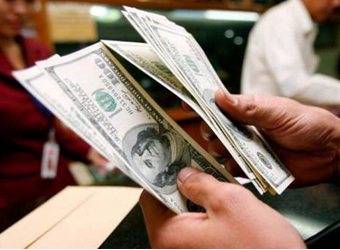Dollar prices held steady above a three-year low versus a basket of currencies on Friday, marking a fifth week of falls and its longest losing streak since May 2015 as worries over a possible U.S. government shutdown weighed.
On Thursday, the U.S. House of Representatives passed a bill to fund government operations through to Feb. 16 and avoid agency shutdowns from Saturday when existing allocations expire. The bill has yet to be approved by the Senate, where it faces an uncertain future.
Democratic Senate leader Chuck Schumer met with Republican President Donald Trump on Friday to find ways to avert a shutdown. Schumer suggested some progress was made but they still had “a good number of disagreements.”
“At the start of the week, it was an outside risk. Now it’s a real risk,” Vassili Serebriakov, currency strategist at Credit Agricole in New York, said of a government shutdown.
Even as the likelihood of a shutdown grew, the greenback managed to hold steady against a group of major currencies on a trade-weighted basis. Some investors downplayed a possible shutdown, saying the market impact would be mild anyway. “It’s more a political event than an economic one,” said Alessio de Longis, portfolio manager for OpperheimerFunds’ global multi-asset group. “We have been in this situation before.”
“It’s more a political event than an economic one,” said Alessio de Longis, portfolio manager for OpperheimerFunds’ global multi-asset group. “We have been in this situation before.”
The trade-weighted dollar index was last up 0.21 percent at 90.68.
It touched the lowest level since December 2014 this week, with investors selling on the view that more central banks will join the Federal Reserve in raising interest rates, after years of ultra-loose policy adopted to combat the 2008 global financial crisis and subsequent recessions.
The euro was down 0.14 percent at $1.222, below a three-year high of $1.2323 touched on Wednesday.
The common currency booked a fifth straight week of gains in advance of next Thursday’s European Central Bank meeting.
The dollar was down 0.30 percent at 110.76 yen, with its rebound from Wednesday’s four-month low of 110.19 yen already fading even as benchmark U.S. 10-year yield rose to the highest level since Sept. 2014.
A slim reduction in the Bank of Japan’s bond purchases this month spurred speculation about a possible pullback in its policy, even though many market players think any move will be many months away.
“Markets are increasingly sensitive to the prospect of a less-dovish BOJ, which is putting pressure on dollar/yen,” UBS Wealth Management analysts said in a note.
They added that they will be looking to the BOJ’s policy meeting next week to gain more clarity on its stance.
“For now, we do not think the BOJ has any urgency to shift its yield curve control regime,” they added.
Another factor behind the dollar’s weakness has been global investors, including sovereign wealth funds and central banks, favoring other currencies.
Source: Reuters
